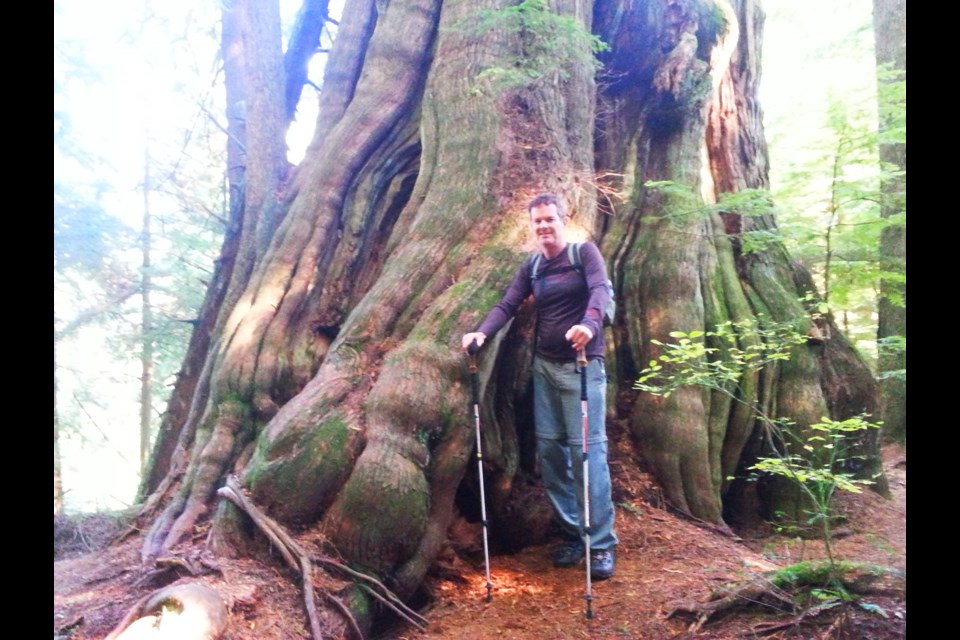Summer may be glorious, but rain can fall any time of year in Vancouver. The next time the wet weather gets you down, thank it for the rainforests we have here in southwestern B.C.
This climate has produced some of the largest trees on Earth, and the rainforest around the city is blessed with numerous giants — the biggest of which still stand along a little-used trail on the west side of Lynn Creek.
For the price (none) of a four-hour hike, you can give a cedar colossus a hug some future rainy day. Or even on a sunny day this week. But keep in mind you’ll need at least a few people to get your arms completely around these giants.
The west side of Lynn Creek used to be more popular for hiking before Lynn Headwaters Regional Park on the east side was opened to the public in 1985. These days, the base of Mt. Fromme has been taken over by numerous mountain bike trails. But the old hiking trail remains; it’s fairly well marked, though a little grown-over in spots and a little sketchy at some creek crossings. This is not a hike for novices.
The trailhead for this hike is the Baden-Powell Trail entrance on the west side of the Lynn Headwaters Park road. The hike begins with a series of staircases that ascend a cliff, with a total of 210 steps by my count. Once this lung-buster is completed, you emerge in the rainforest.
There are numerous routes to get you to the largest of the giant trees. The simplest route is to take the Baden-Powell Trail west to the Mountain Highway gravel road, turn right, and follow the road uphill until you see a sign on the right for the Cedar Tree Trail.
However, you can also take a more interesting series of multi-use trails popular with bikers (Lower Griffen Switchbacks, Lower Griffen and Upper Griffen) to get to the same spot. Just remember to stay right at every intersection. Also, be on the lookout for mountain bikers, some of whom helped build and maintain these trails.
Along the way you’ll see huge cedar stumps that offer a hint of what this forest used to look like before the clear-cut logging of the early 1900s. There are also remnants of a few old log cabins and campsites hidden in the trees.
The Cedar Tree Trail starts as a wide gravel path but quickly narrows to dirt, rocks, roots and cedar planks that roughly follow the remains of a century-old logging road. Follow the yellow tree markers to avoid losing the trail.
At the first major creek crossing (on a sturdy new bridge), you can see the destruction caused by a rock and mudslide that washed out the trail a few years ago. Look to the right for pieces of the previous plank bridge.
Two more creeks (neither with a bridge) require careful rock-hopping. Shortly after climbing out of the gully of the second bridge-less creek, look for a rock cairn on the right.
Turn right and follow orange flagging tape along a downhill trail, which takes you over, under and around fallen trees for 10 minutes until you reach the biggest tree you might ever see in your lifetime.
This monstrous old-growth western red cedar is close to five metres in diameter and approximately 700 years old. It’s truly an awe-inspiring and majestic specimen worthy of the dozens of photos you’ll likely take.
However, it is not perfect, and this is the only reason the cedar is still standing. Look up about 20 metres to the cleft where the tree twists and splits into two spires, each with broken tops. Logging crews spared split trees like this because their wood was not deemed the same quality as un-split cedars.
The cedar is surrounded by second growth trees more than 100 years old that all look like twigs in comparison. About 25 metres downhill, a giant Douglas fir is perched on the edge of a cliff. It’s also worth a look before returning back uphill.
Retracing your steps to the main trail, you can turn left and head back home. Or you can turn right and follow the Cedar Tree Trail for another hour (over 1.5 kilometres) to visit a second, slightly smaller giant cedar.
However, this portion of the hike is only recommended for experienced and properly equipped hikers. And never do it alone. Many sections of the trail are steep and treacherous.
Mike Hanafin is an avid backcountry hiker who can see the forest and the trees.



